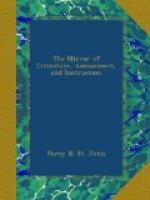The Chair is not the only memorial of Bede preserved in this neighbourhood. About one mile west of Jarrow is a Well, still called St. Bede’s, to which it was customary, almost as late as the middle of the last century, to convey diseased children, and, after dropping in a crooked pin, to dip them for the recovery of their health: round the Well, also, on every Midsummer Eve, was a great resort of the neighbouring people, with bonfires, music, and dancing. The mystical properties of the Well are not of difficult solution: since it was reasonable enough to associate the restorative effects of cold bathing with sanctity; and the rejoicings at the spring were indicative of the gladness of the people, in connexion with a name endeared to them, by the wisdom, virtue, and benevolence, of its possessor.
[5] Sir James Mackintosh.
* * * * *
GOLD-BEATING.
Early in the 17th century, great surprise was excited upon the promulgation of the fact, that the Parisian gold-beaters could produce 1,600 leaves, or 105 square feet, from one ounce of gold; but the surprise of the public was redoubled, when, upon the discovery of the fine skin now in use, they found that 147 square feet could be produced from the same quantity.
ANTIQUARES.
* * * * *
MONUMENT OF A CRUSADER.
In the great north aisle of Winchester Cathedral, in a dark nook immediately adjoining the wall of the choir, is the mutilated effigies of a Crusader, recumbent on an oblong stone. The figure is armed cap-a-pee, in a hauberk,[6] with sword and shield, the latter of which bears, quarterly, two bulls passant, gorged with collars and bells, and three garbs, being the armorial bearings of the noble family of De Foix, of which was the Captal de Buck, one of the first Knights of the Garter, at the commencement of the Order. On a slab, placed perpendicularly against the adjoining wall of the choir, are several shields, emblazoned with the arms of the royal families of England, France, Castile. Leon, &c. There is no inscription remaining to point out for whom this figure was intended; but Gall, in his “Antiquities of Winchester,” gives the following inscription as having existed on the monument:—"Hic jacet Willielmus comes de insula Vana, alias Wincall;” the parish of that name lies on the river Itchin, and might formerly have been insulated. The verger of Winchester Cathedral, in reply to an inquiry made by the editor of the “Antiquarian and Topographical Cabinet,” said, it was a knight of the name of Fox, evidently meaning De Foix. This figure suffered severely from the iconoclasts, at the time of Cromwell’s taking possession of Winchester. Amongst other mutilations, they have entirely hacked away the right leg, leaving only the foot connected with the lion couchant, against which the figure rests.




